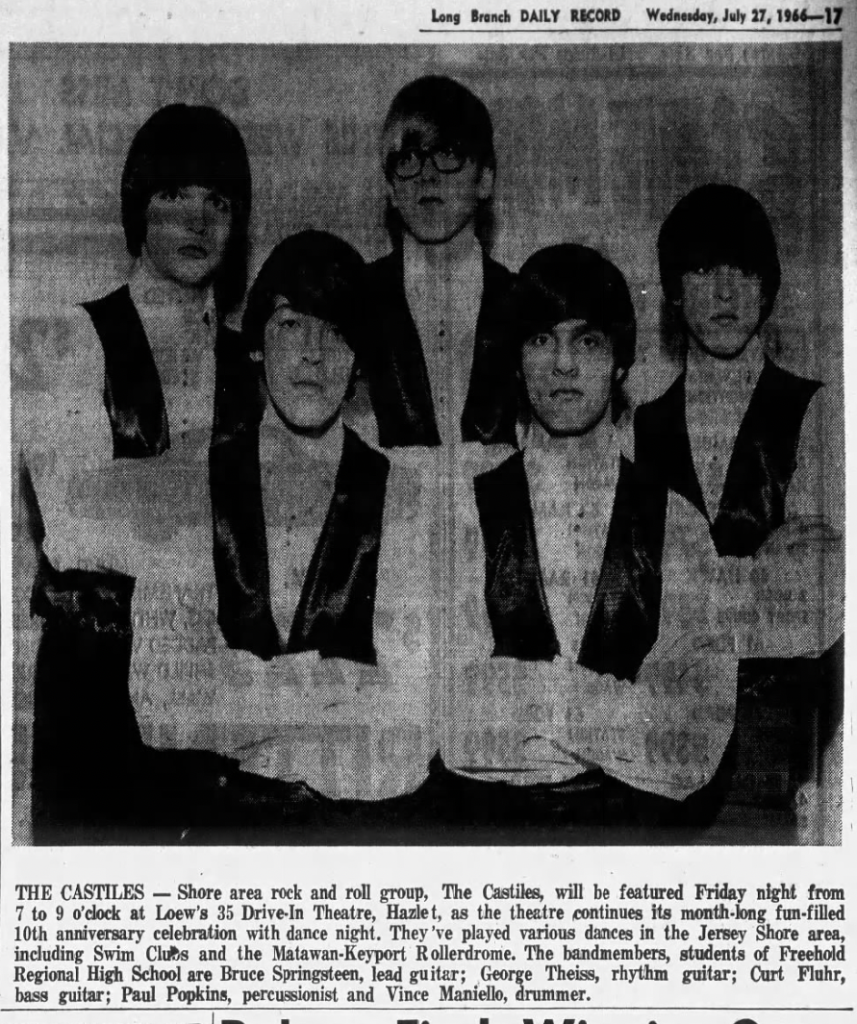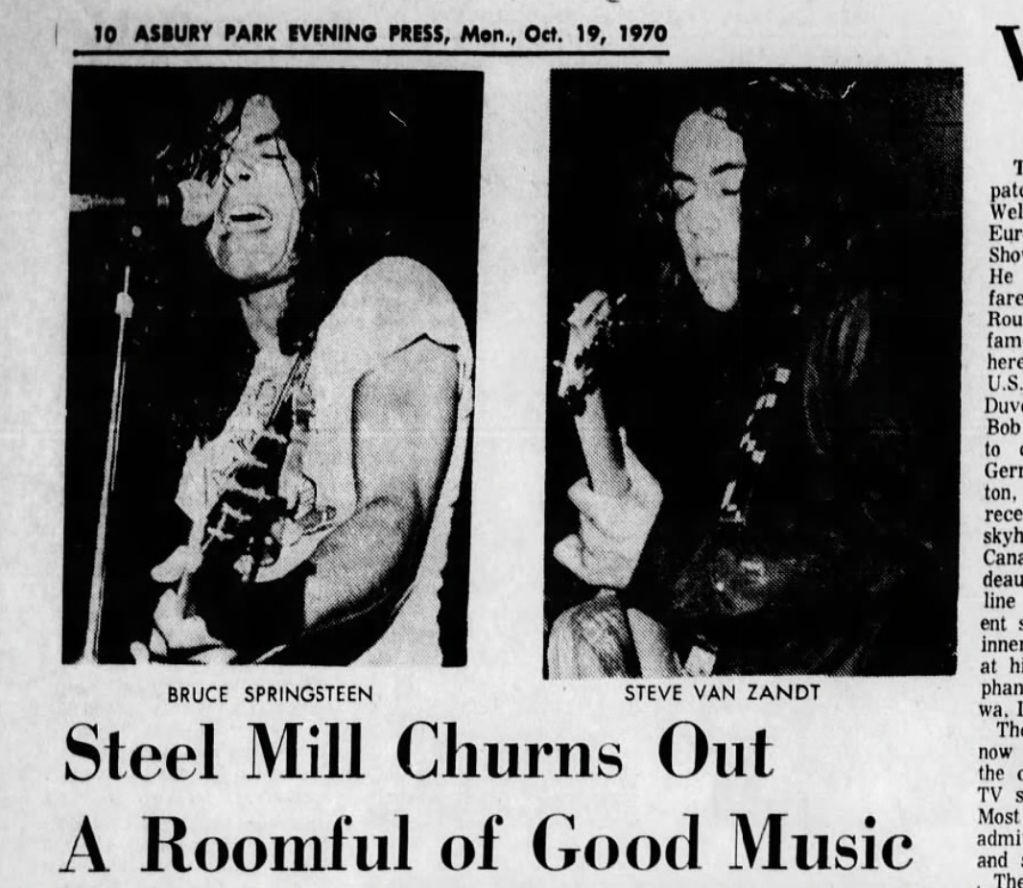Born: September 23, 1949
Before there was Bruce Springsteen and the E Street Band … there was Bruce Springsteen and the Castiles; Earth; Child; and Steel Mill. So many bands!
The Castiles (Springsteen on lead guitar, George Theiss on rhythm guitar, Curt Fluhr on bass, Paul Popkins percussion and Vince Maniello on drums) were Springsteen’s first band. The first reference I found was in the July 27, 1966, edition of The Daily Register, Red Bank, New Jersey.

Under a photo of the band, decked out in matching long-sleeve, white shirts and dark vests, the caption read:
LOEW’S ‘35’ Drive-In theatre, Hazlet [New Jersey], continues its 10th anniversary celebration with “Dance Night” Friday from 7 to 9 p.m. Featured will be the Castiles, Rock and Roll band which has a ‘different’ style and beat. Band members are students of Freehold Regional High School.
This was the summer before Springsteen’s senior year of high school at Freehold. Castile was a brand of soap and shampoo.
The next mention was in the June 20, 1967, edition of The Daily Register. The headline was “318 Receive Diplomas At Freehold Regional.” The story listed all 318 graduates, which included Springsteen. Perhaps this was his Independence Day.
Springsteen’s next band was Earth. Here’s an ad for their August 17, 1968, show at the Off Broad St. Coffee House in Red Bank.

Earth (also called The Earth) played “a benefit performance at the Hotel Diplomat here [in New York City) to collect funds for a proposed medical clinic in the Lower East Side,” wrote The Daily Register on December 27, 1968. The story listed the members of Child as: Springsteen, John Graham and Mike Burke.
From The Earth, Springsteen landed in Child. A story in The Daily Register on April 4, 1969, included a photo of Child, who were performing at the Pandemonium nightclub (Ocean Township, New Jersey) and identified the members as: Springsteen, Dan Federici, Vini “Mad Dog” Lopez and Vinnie Roslin.
Federici (keyboards/organ) and Lopez (drums) would later become founding members of the E Street Band.

Child morphed into Steel Mill by the end of 1969. Joan Pikula a reporter with the Asbury Park Press was an early supporter. She wrote the following on April 15, 1970:
“They were called ‘Child’ in the beginning and it was under that name the four-man rock group built a following like no other group before or after in the [New Jersey] Shore area. All the kids talked about last year was Child; Child and that ‘wild’ guitar player, Bruce Springsteen; Child and that ‘way-out’ keyboard man, Danny Federici; Child and that fantastic drummer, Vini Lopez; Child and that bass player, Vinnie Roslin.
“Now they’re called Steel Mill. They’re home from California where they were lauded by Philip Elwood in the San Francisco Examiner as ‘the first big thing that’s happened to Asbury park since the good ship Morro Castle burned to the waterline off that Jersey beach in ’34.”
The Morro Castle? An ocean liner that ran aground and caught fire of September 8, 1934. 137 passengers and crew members died.
Pikula’s article continued:
“They’ve got a new bass player – Stevie Van Zandt replaced Roslin – and they’re set to go … Steel Mill, which sends out a neat blend of hard rock and country, is interested in playing colleges and concert halls. They’ve had it with night clubs. The clubs, they say, want to provide reproductions of hit records and shy away from original material. Steel Mill wants to provide original material, and they do, written mainly by lead singer-guitarist Springsteen …”
Van Zandt would eventually join the E Street Band.

Pikula followed up on April 20, 1970, with a review of Steel Mill’s concert at Ocean County College that attracted a crowd of 1,500. She wrote:
“It’s not a one-man group, but Springsteen is definitely the focal point. He sings in a compelling voice that runs the gambit from screaming blues to country to rock and he makes the run with ease and skill. The main thing about Springsteen is that he communicates. He does it through his throat and through the guitar, an instrument completely under his control and from which he draws a fantastic range of emotions … Springsteen’s songs are blues and they’re solid rock. They’re physical and they’re political. They’re gentle and they’re angry. And, most importantly, they’re really fine.”
Pikula was the first journalist to “discover” Springsteen. “Her articles meant the world to us,” Lopez said in a 2015 obituary article after she died.
Mayhem at the Swim Club
September 12, 1970: Steel Mill was the final act of a multi-group rock concert held at the Clearwater Swim Club in Middleton, New Jersey.
According to The Daily Register:
“The disturbance followed the abrupt close of a concert by the Steel Mill, a local rock group by police at 10 p.m., scheduled closing time of the five-hour event. Police arrested 21 persons, 10 of whom were juveniles, on drug and assault charges. Ten policemen, including Chief Joseph M. McCarthy were injured in the fracas. Because of calls to the ACLU by young persons who claimed police used mace and drew pistols to threaten participants the local chapter is calling on eyewitnesses to ‘evaluate these complaints.’ … Police are continuing a search for Danny Federici of Belmar, organist with the Steel Mill, charged with assault on a police officer and resisting arrest.”

The members of Steel Mill were in the thick of the melee. Pikula attended the concert and was quoted in an article in the Asbury Park Press that ran on September 15, 1970:
“At 10:10 near the end of Steel Mill’s last number, the power was shut off. The instruments went dead … There was an instant of bewilderment, then anger. The crowd jumped up, stomping, and clapping for more music.
“People climbed onto the stage and three patrolmen began to climb up behind the big amplifiers. One of them grabbed one of the amplifiers while climbing and they began to wobble. Danny Federici … was sitting closest to the tottering boxes. He reached up to grab the expensive piece of equipment … The three patrolmen then grabbed him, shaking him, poking him in the chest, shouting. One of them took his nightstick and jammed it into the ribs of Bruce Springsteen … who was standing on the stage still holding his guitar. This was the beginning of the violence.”
The next day, the Asbury Park Press reported the police search “is still under way for Danny Federici … on charges of assaulting a police officer and resisting arrest. To date, no other warrants for band members have been issued …”
The article also quoted a Mrs. George W. Campbell, who attended the concert: “I think what the police did to those kids is a frightening thing … The police came rushing on stage swinging and they seemed more interested in scaring everyone out of their wits than in dispersing the crowd of 3,000 safely …”
The police were never able to serve the warrant on Federici, an evasion that earned him the nickname “The Phantom” from his bandmates.
Springsteen placed this ad in the Asbury Park Press on February 2, 1917.

No, this wasn’t how the big man joined the band. Not quite yet.
Springsteen signed with Columbia Record in May 1972 as a solo act. In October, he put together the backing band that eventually became known as the E Street Band. The original members were: Federici, Lopez, Garry Tallent, Clarence Clemons and David Sancious. Van Zandt joined on a permanent basis a couple years later.
The group’s Greetings from Asbury Park, N.J. album was released on January 5, 1973.
If you found this story interesting, you might like to read my From Unknown to Famous stories about Ernest Hemingway, Marilyn Monroe, Amelia Earhart, Babe Ruth, Jackie Robinson, Elvis and Alex Trebek. Please subscribe to this blog and get alerts every time I post a new one (lots more are coming).

